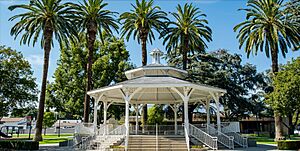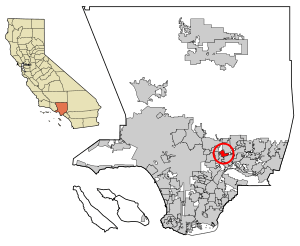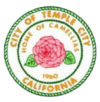Temple City, California facts for kids
Quick facts for kids
Temple City, California
|
|||
|---|---|---|---|

Temple City Park
|
|||
|
|||
| Motto(s):
"Home Of Camellias"
|
|||

Location of Temple City in Los Angeles County, California
|
|||
| Country | |||
| State | |||
| County | Los Angeles | ||
| Incorporated | May 25, 1960 | ||
| Named for | Walter P. Temple | ||
| Area | |||
| • Total | 4.00 sq mi (10.37 km2) | ||
| • Land | 4.00 sq mi (10.37 km2) | ||
| • Water | 0.00 sq mi (0.00 km2) 0% | ||
| Elevation | 400 ft (122 m) | ||
| Population
(2020)
|
|||
| • Total | 36,494 | ||
| • Density | 9,124/sq mi (3,519.2/km2) | ||
| Time zone | UTC-8 (Pacific) | ||
| • Summer (DST) | UTC-7 (PDT) | ||
| ZIP code |
91780
|
||
| Area code | 626 | ||
| FIPS code | 06-78148 | ||
| GNIS feature ID | 1656640 | ||
| Temple City, California | |||||||||||
|---|---|---|---|---|---|---|---|---|---|---|---|
| Traditional Chinese | 坦普爾市 | ||||||||||
| Simplified Chinese | 坦普尔市 | ||||||||||
|
|||||||||||
| Alternative Chinese name | |||||||||||
| Chinese | 天普市 | ||||||||||
|
|||||||||||
Temple City is a city in Los Angeles County, California. It is located northeast of downtown Los Angeles. The city sits at the base of the San Gabriel Mountains.
Temple City is part of a group of cities in the western San Gabriel Valley. These cities include Pasadena, Arcadia, Alhambra, San Marino, and San Gabriel.
Contents
History of Temple City
The town of Temple started on May 30, 1923. A man named Walter P. Temple bought 400 acres of land. This land was about 4 miles east of San Gabriel. It used to be part of Lucky Baldwin's Rancho Santa Anita.
The first town area is where Temple City is today. It is bordered by Garibaldi Avenue, Baldwin Avenue, Live Oak Avenue, and Encinita Avenue.
Walter Temple was born on Rancho La Merced. This area is now part of Montebello. It was also the first site of the San Gabriel Mission. The mission was founded by Franciscan Fathers. It was near the San Gabriel River. This river was once called "Rio de los Temblores," meaning "River of the Earthquakes." Today, it is known as the Rio Hondo.
Walter Temple wanted to build a community where regular people could afford homes. He divided the land into lots. He also created a park facing Las Tunas Drive. He named streets after his friends and family. These names include Workman, Kauffman, Rowland, Temple, and Agnes.
Temple also helped get streets paved and electricity installed. He asked the Pacific Electric Railway Company to extend its train line. This line went from Los Angeles to Alhambra. The extension helped Temple City grow steadily. Statues of train passengers along Rosemead Boulevard remember this railway.
In 1925, the Women's Club of Temple City was founded.
How Temple City Got Its Name
The town was first called "City of Temple." It was named after its founder, Walter Temple. However, in 1926, the United States Postmaster General asked for a name change. Mail was accidentally going to Tempe, a town near Phoenix.
So, the town was officially named "Temple City." It was a city in name only until after World War II. Many people moved there, and it officially became an incorporated city on May 25, 1960. This led to the name "City of Temple City." Merrill Fitzjohn became the city's first mayor.
Challenges in Leadership
In 2009, there were concerns about some city leaders. The Los Angeles County District Attorney looked into claims that some officials were involved in improper actions. These actions were related to a large mall project.
As a result, some city leaders resigned or were voted out of office. This event led to changes in the city's government. The community worked to move forward from these challenges.
Population and People
| Historical population | |||
|---|---|---|---|
| Census | Pop. | %± | |
| 1960 | 31,838 | — | |
| 1970 | 31,034 | −2.5% | |
| 1980 | 28,972 | −6.6% | |
| 1990 | 31,100 | 7.3% | |
| 2000 | 33,377 | 7.3% | |
| 2010 | 35,558 | 6.5% | |
| 2020 | 36,494 | 2.6% | |
| U.S. Decennial Census 2020 | |||
Population in 2020
The 2020 United States census showed that Temple City had 36,494 people.
Population in 2010
The 2010 United States Census reported that Temple City had 35,558 people. The city had about 8,877 people per square mile.
The people living in Temple City were from many backgrounds. About 33.6% were White, 0.8% African American, and 0.4% Native American. A large group, 55.7%, were Asian. About 6.5% were from other races, and 2.9% were from two or more races. About 19.3% of the people were Hispanic or Latino.
Most people (98.8%) lived in homes. The average household had about 3 people. The median age in Temple City was 42.0 years old.
Geography
Temple City covers a total area of 4.0 square miles (10.37 square kilometers). All of this area is land.
City Services
The Los Angeles County Fire Department provides fire protection for Temple City. The Los Angeles County Sheriff's Department (LASD) has a station in Temple City. This station helps keep the city safe.
Interesting Facts
Temple City has some cool facts about its past.
- Winchell's Donuts started in Temple City on October 8, 1948. Even though there isn't a store there now, it's where it all began!
- In the 1970s, Pete & Jake's Hot Rod Repair was in Temple City. They were known for making amazing custom cars, like The California Kid.
- A restaurant called Bistro Na's opened in Temple City in 2016. It earned a Michelin star in 2019, which is a very high honor for restaurants.
Temple City Library
A beautiful mural was added to the Temple City Library in 2011. Over 20 students from Temple City helped paint it. A famous muralist named Art Mortimer guided them.
The mural is 8 feet tall and 28 feet wide. It shows famous authors and important symbols of reading. It was a team effort between the city, the county, and the Temple City Unified School District. The mural helps show how important the library is to the community.
Community Events
Temple City hosts several fun events throughout the year.
Camellia Festival
The Camellia Festival is a very special event in Temple City. It started in 1944. The Women's Club of Temple City held a contest, and the winning slogan was "Temple City, Home of Camellias." This led to the annual festival.
The festival celebrates family life and encourages young people to join community groups. Only members of recognized youth groups can enter the parade. The festival crowns two first-graders as "Royalty" in early February.
The main festival happens on the last weekend of February. It starts with a parade on Saturday morning. The parade does not allow commercial floats. All the floats are made by young people and follow a yearly theme. There is also a carnival in Temple City Park. You can enjoy games and food booths run by local groups. There are also cultural entertainment events for everyone.
What began as a small parade of children tossing camellia flowers has grown a lot. Now, about 5,000 children and over 20,000 visitors come to Temple City each year for the festival.
Parish Fiesta
The annual Saint Luke's Parish Fiesta takes place at the St. Luke the Evangelist Catholic Church. It happens in April and lasts for three days. The fiesta has game booths, rides, and food stalls for everyone to enjoy.
About 900 volunteers, both young and old, help out at the fiesta. Many have been volunteering for over 50 years! Each year, about 10,000 people come to enjoy the food, rides, and entertainment.
Farmers Market
Temple City has a Farmer's Market every Sunday. It is open from 8:30 a.m. to 12:30 p.m. You can find it in the parking lot between City Hall and Temple City Park.
Education in Temple City
Most students in Temple City attend schools in the Temple City Unified School District (TCUSD). Some students also go to schools in the Arcadia Unified School District or the El Monte City School District.
The Temple City Unified School District has seven schools:
- La Rosa Elementary School
- Cloverly Elementary School
- Emperor Elementary School
- Longden Elementary School
- Oak Avenue Intermediate School
- Temple City High School
- Doug Sears Learning Center
The Temple City Board of Education is proud of its schools. They call their district "A District of Distinguished Schools." This is because every school in the district has been named a "distinguished school" by the state of California at some point. This honor means the schools are excellent in areas like academics and student behavior.
Saint Luke's Parish School is a private school for grades K-8. It is located at Saint Luke the Evangelist Church. The school was founded in 1947.
Famous People From Temple City
Many notable people have connections to Temple City:
- Clyde Beck (1900–1988) – A professional baseball player for the Chicago Cubs and Cincinnati Reds.
- Richard Drew (born 1946) – A photo-journalist for the Associated Press. He took the famous picture "The Falling Man."
- Frank Finch (1911–1992) – A sportswriter for the Los Angeles Times.
- Hal Finney (1956-2014) – A computer scientist.
- David Klein (born 1946) – The inventor of the Jelly Belly brand. He lived in Temple City when he came up with the idea for the candy company.
- Steven Lindsey (born 1960) – A NASA astronaut who has flown five space shuttle missions.
- Xpecial (born 1992) – A well-known professional gamer in the North American League of Legends.
Sister Cities
Temple City has special connections with cities in other countries. These are called Sister Cities:
 City of Hawkesbury, Australia (since 1984)
City of Hawkesbury, Australia (since 1984)- Magdalena de Kino, Sonora, Mexico
See also
 In Spanish: Temple City para niños
In Spanish: Temple City para niños




